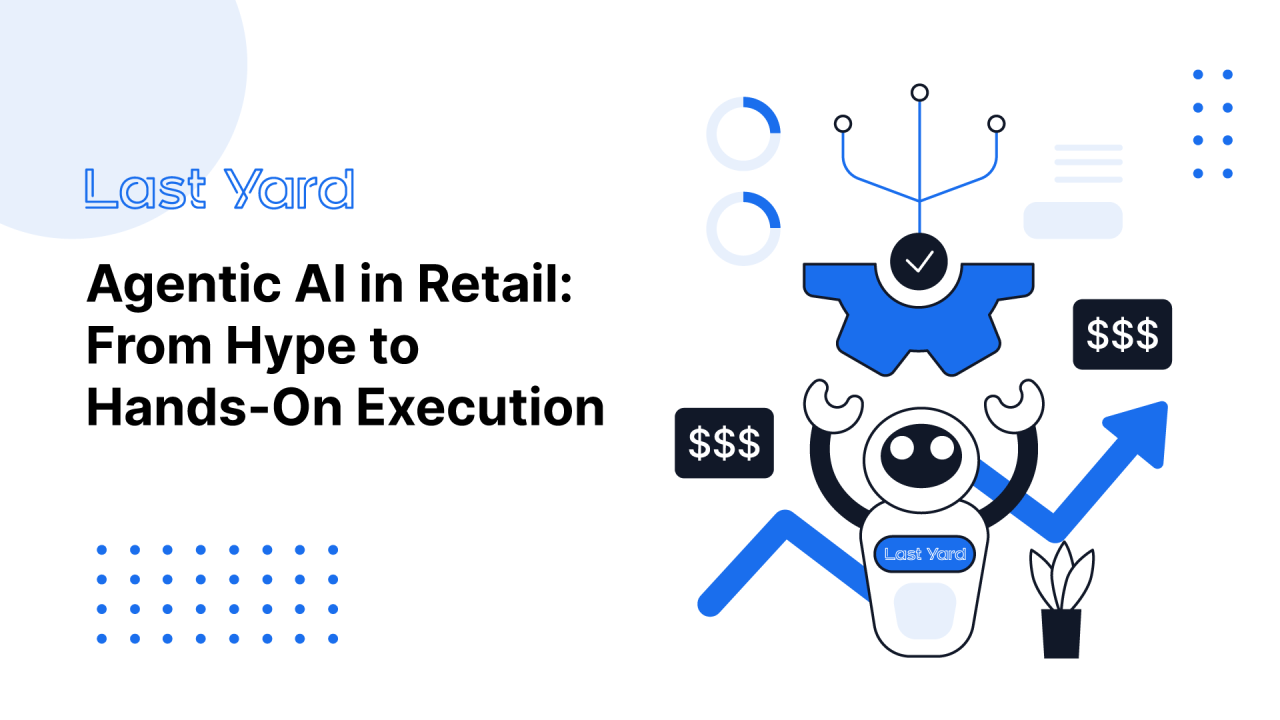Artificial intelligence is evolving from tools that predict or generate to ones that can act autonomously – so-called agentic AI. This next frontier enables AI systems to take initiative toward goals without constant human prompts. The concept has stirred plenty of hype, especially after generative AI’s rise, but retailers are increasingly looking past flashy demos to practical applications.
In fact, interest in agentic AI for retail is “rising fast” as companies seek to future-proof their strategies. Nowhere is the potential more tangible than in retail operations. Store operations involve thousands of decisions and repetitive tasks every day – an ideal playground for autonomous agents to boost efficiency.
The promise is moving from reactive to proactive retail management. Instead of simply flagging issues, AI agents can fix them in real time. The result is a leap in speed, consistency, and personalization across brick-and-mortar stores, turning the hype into real operational value.
Key Operational Use Cases for Agentic AI in Retail
Agentic AI is already delivering value in several core operational areas. Below, we explore four high-impact use cases in retail stores – from coaching employees to optimizing merchandising – where autonomous agents are making a difference today.
1. AI-Powered Store Team Coaching and Training
Retail success hinges on well-prepared, customer-focused staff. Yet training frontline teams for every scenario is challenging. Enter AI training agents – autonomous systems that simulate real-world interactions to coach store employees.
These agentic AI solutions utilize immersive role-play to prepare staff for high-stress situations (think upset customers or complex team dynamics). For example, an agent can act as a virtual customer in a realistic dialogue, providing the employee with real-time feedback and tips.
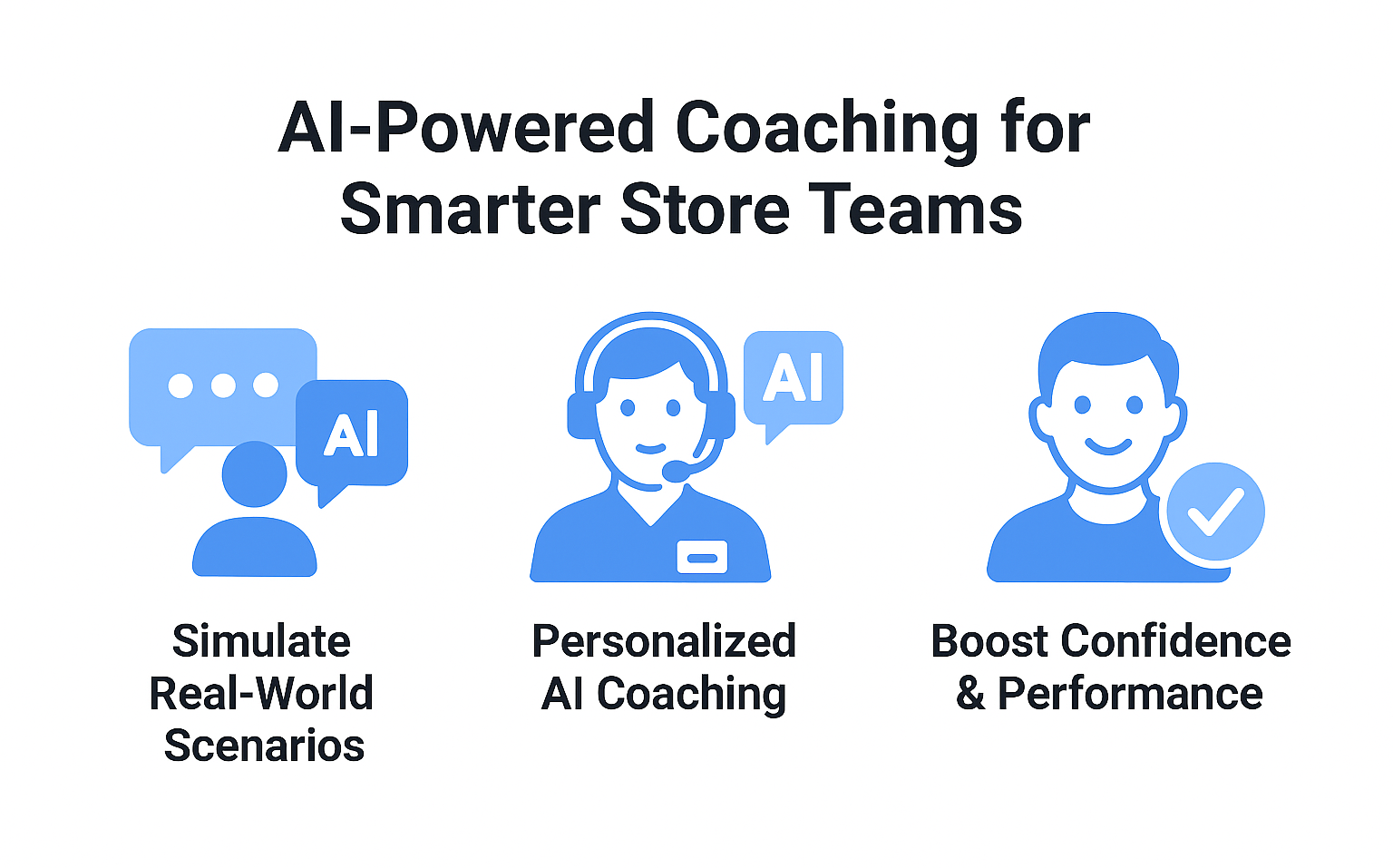 This hyper-personalized coaching adapts to the learner’s needs, reinforcing best practices within the company. Early results are promising: in one survey, 75% of retail employees reported anxiety about handling difficult interactions, and nearly 40% said they’d prefer practicing with AI over a human manager. By allowing staff to rehearse challenging situations in a safe environment, AI coaches help reduce on-the-job stress, lower turnover rates, and improve overall performance.
This hyper-personalized coaching adapts to the learner’s needs, reinforcing best practices within the company. Early results are promising: in one survey, 75% of retail employees reported anxiety about handling difficult interactions, and nearly 40% said they’d prefer practicing with AI over a human manager. By allowing staff to rehearse challenging situations in a safe environment, AI coaches help reduce on-the-job stress, lower turnover rates, and improve overall performance.
In short, agentic AI is augmenting store managers as a virtual coach, scaling one-to-one mentorship and sharpening frontline skills – all of which translates to better customer experiences on the sales floor.
2. Autonomous Compliance and QA
Consistency and compliance are non-negotiable in retail operations, from accurate price tags to planogram adherence. Traditionally, store managers rely on manual checks and audits, which are time-consuming and prone to human error. Agentic AI offers a smarter solution: autonomous compliance QA.
These AI agents use computer vision and data feeds to constantly audit store conditions, flagging and even fixing issues without waiting for human intervention. For instance, some retailers now deploy shelf-scanning robots as “eyes and ears” in the aisle. Walmart, for example, uses autonomous robots with image recognition to patrol stores and detect missing inventory or incorrect prices.
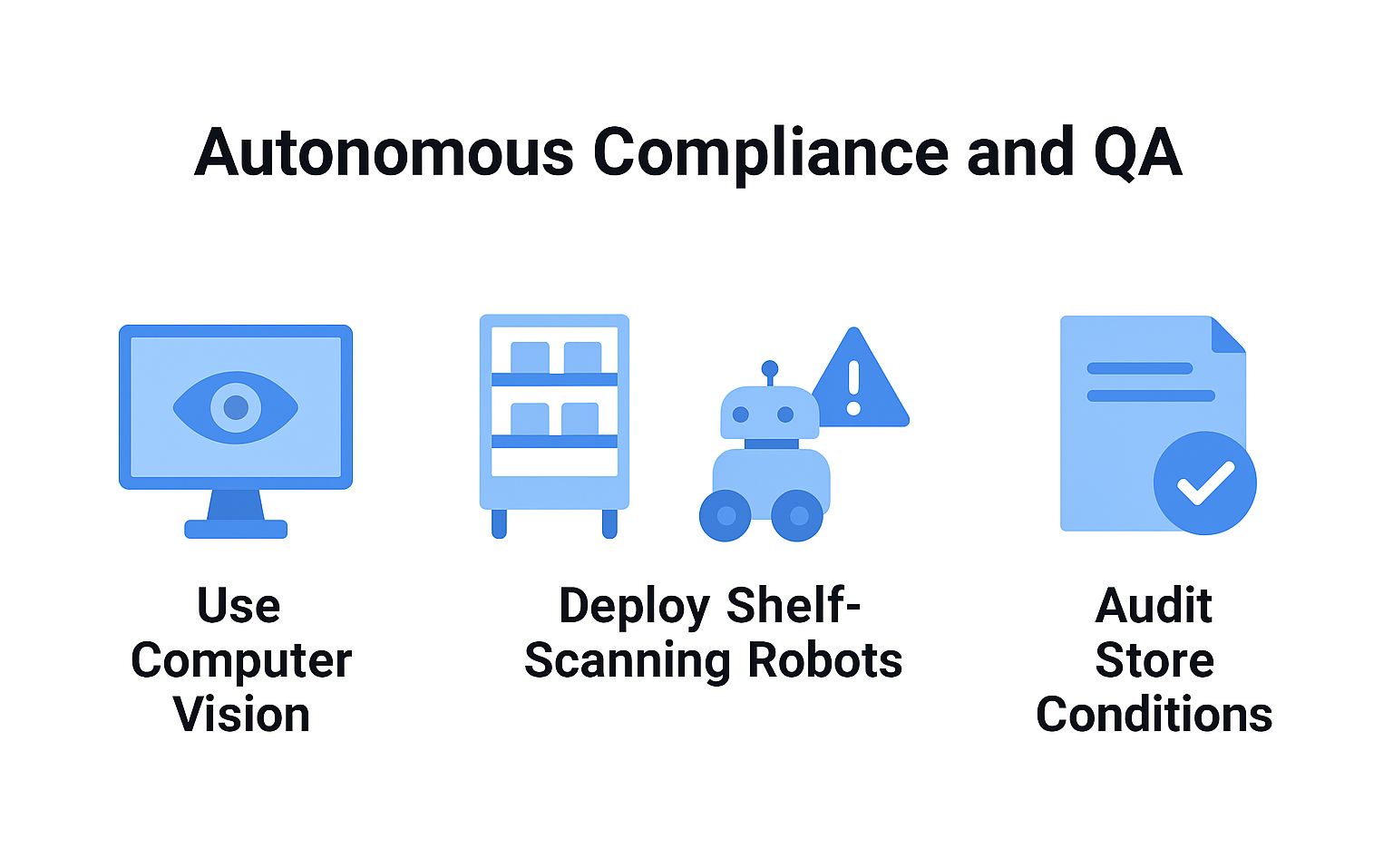 When the AI spots an out-of-stock or a misplaced item, it immediately alerts staff or triggers a restock request, preventing sales from slipping through the cracks. The impact is significant: fewer stockouts, fewer pricing errors, and faster corrective action, all leading to higher sales and customer satisfaction.
When the AI spots an out-of-stock or a misplaced item, it immediately alerts staff or triggers a restock request, preventing sales from slipping through the cracks. The impact is significant: fewer stockouts, fewer pricing errors, and faster corrective action, all leading to higher sales and customer satisfaction.
Beyond robotics, agentic AI can also integrate with camera systems or digital shelf sensors to ensure promotional signs are correctly placed and legal rules (like age-restricted product signage) are followed. By acting as an always-on compliance inspector, AI agents free up human employees from rote checks and give management peace of mind that every store is up to standard.
3. Merchandising Optimization and Planogram Adherence
Merchandising – deciding how products are arranged and promoted in stores, is both an art and a science. It’s also a domain ripe for agentic AI optimization. Autonomous merchandising agents can digest sales data, shopper traffic patterns, and even local trends, then make on-the-fly adjustments to maximize category performance.
One immediate use case is planogram adherence and category resets. After a major reset of a product category, sales might slip for any number of reasons. Instead of waiting weeks for a manual review, an AI agent can continuously monitor performance and pinpoint root causes in real time.
For example, an agent, upon noticing a post-reset sales dip, quickly determines if non-compliant shelf placements or out-of-stocks are to blame. The agent doesn’t stop at diagnosis; it acts. It might autonomously generate restock orders for missing items, suggest reordering the display to meet the planogram, or even tweak promotions for underperforming products.
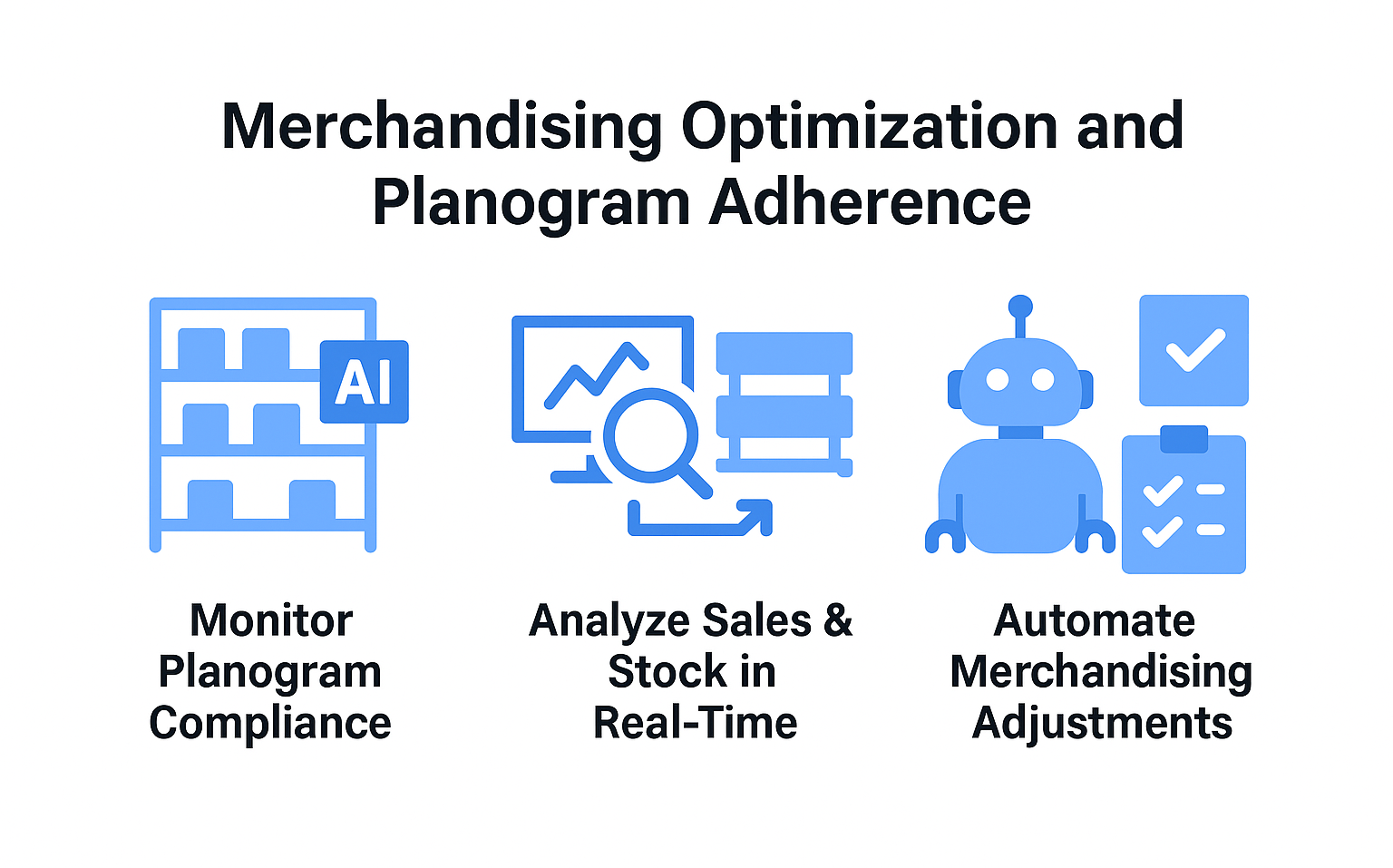 This level of always-on category management was previously unattainable. Retailers also use agentic AI to analyze heatmaps and foot traffic, identifying which areas of the store draw shoppers and which products capture attention. The AI can then recommend (or enact) changes in product placement and inventory distribution to capitalize on these insights.
This level of always-on category management was previously unattainable. Retailers also use agentic AI to analyze heatmaps and foot traffic, identifying which areas of the store draw shoppers and which products capture attention. The AI can then recommend (or enact) changes in product placement and inventory distribution to capitalize on these insights.
Early adopters report significant efficiency gains. AI-driven merchandising reviews that once took a category manager four hours each week can now be done in minutes, with the agent highlighting issues (like a competitor’s promotion impacting sales) and proposing effective countermeasures.
In summary, agentic AI serves as a tireless merchandiser that keeps shelves optimized, ensuring the right products are in the right place at the right time.
4. The Virtual Regional Manager for Multi-Store Operations
In large retail chains, regional and district managers oversee dozens of stores. It’s a balancing act of monitoring performance, compliance, staffing, and local competition. Agentic AI is now stepping into this role as a kind of virtual regional manager that can scale oversight across many locations simultaneously.
These AI agents ingest data from all stores in real time, from point-of-sale trends, foot traffic, social media cues, and even competitor activities, to spot opportunities or issues that a human might miss until the next weekly report.
For instance, an agent might notice that a competitor across town just launched a big sale on a product your store also carries. The AI can autonomously mitigate competitive threats by adjusting local pricing or promotions within hours, not days, to protect market share.
To illustrate this, an AI agent can forecast the impact on each nearby store’s sales and proactively roll out defensive strategies (such as targeted discounts or loyalty incentives) to retain customers when a new rival store opens in the area. Similarly, an agentic system can dynamically reallocate stock between stores.
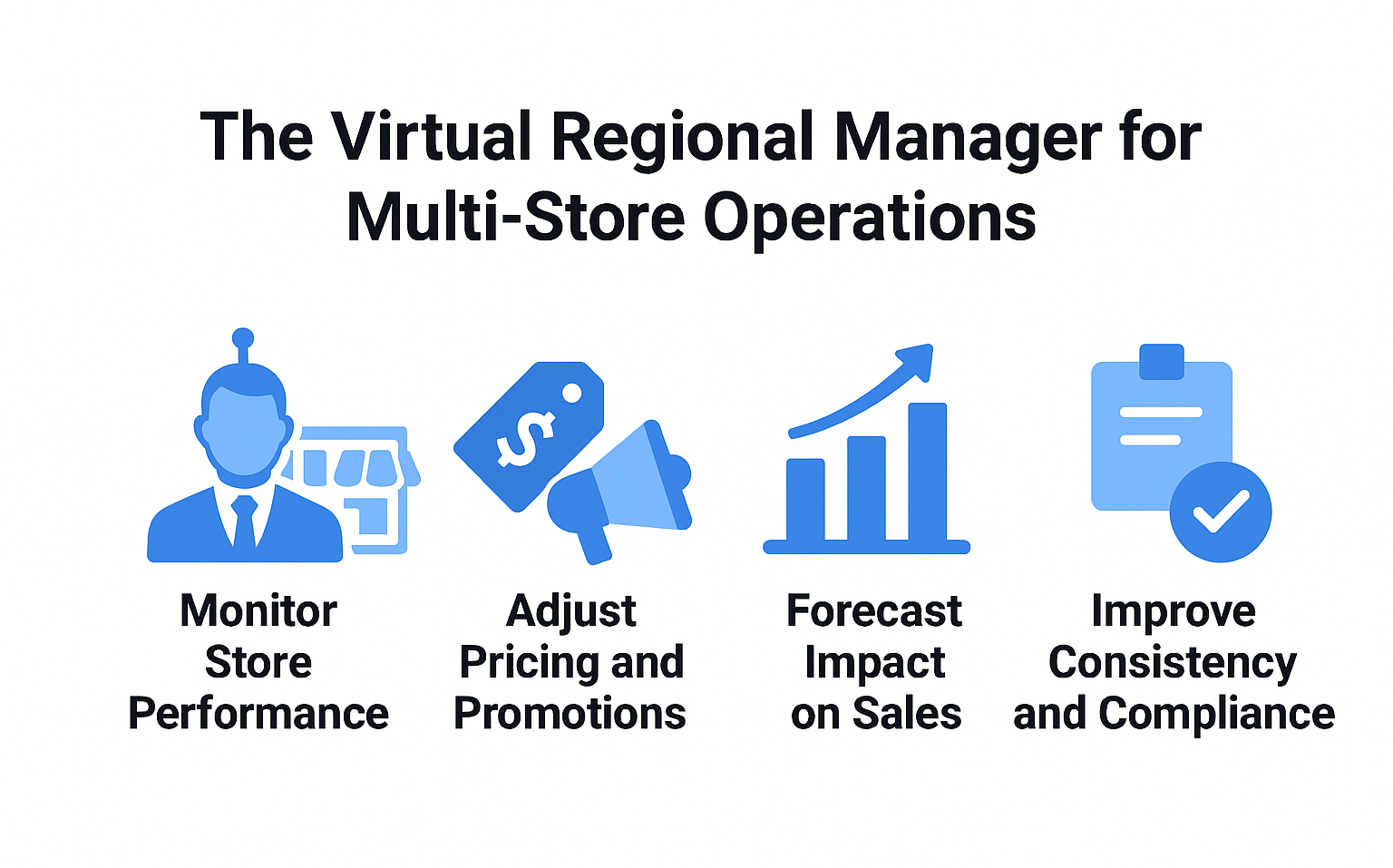 If one location is overstocked on an item that’s selling out at another, the AI triggers a transfer or redirects shipments, acting much like a regional director orchestrating resources.
If one location is overstocked on an item that’s selling out at another, the AI triggers a transfer or redirects shipments, acting much like a regional director orchestrating resources.
Retailers have also begun using these agents to optimize staffing at the network level. By predicting footfall with high accuracy and analyzing conversion rates, the AI suggests scheduling adjustments per store, ensuring labor is allocated where it’s needed most each day.
The benefits of a virtual regional manager are clear: more agile response to local conditions, consistency in execution across stores, and significant time savings for human leaders. Rather than combing through reports, regional managers can rely on AI to surface insights and actions, focusing their attention on strategic decisions and coaching store teams. In practice, this means smoother operations chain-wide and a competitive edge in each micro-market the retailer serves.
5. Dynamic Pricing and Real-Time Promotions
Perhaps the most talked-about retail application of agentic AI is dynamic pricing, the ability to adjust product prices or promotions in real-time, based on live market conditions. In an industry where margins are thin and consumer demand shifts rapidly, getting pricing just right is a perpetual challenge.
Agentic AI approaches this with a blend of ruthlessness and finesse. It continuously analyzes factors like sales velocity, inventory levels, competitor pricing, time of day, and even weather or local events, and then acts by updating prices or promotions accordingly.
How Industry Leaders Are Doing It
This isn’t theoretical – major retailers are doing it today. Walmart, for example, has AI that monitors competitors and market demand to tweak prices in real time, ensuring they stay competitive while still protecting margins. Another case in point is Macy’s, which implemented an AI-driven dynamic pricing strategy to adjust prices across its product range, reacting to inventory and demand signals (industry observers credit this with improving sell-through and profitability).
The beauty of agentic pricing is how granular it can be. A system might mark down a single SKU in one store for a few hours to spur sales, then revert once targets are met. It’s like having an expert merchant making price calls 24/7, store by store.
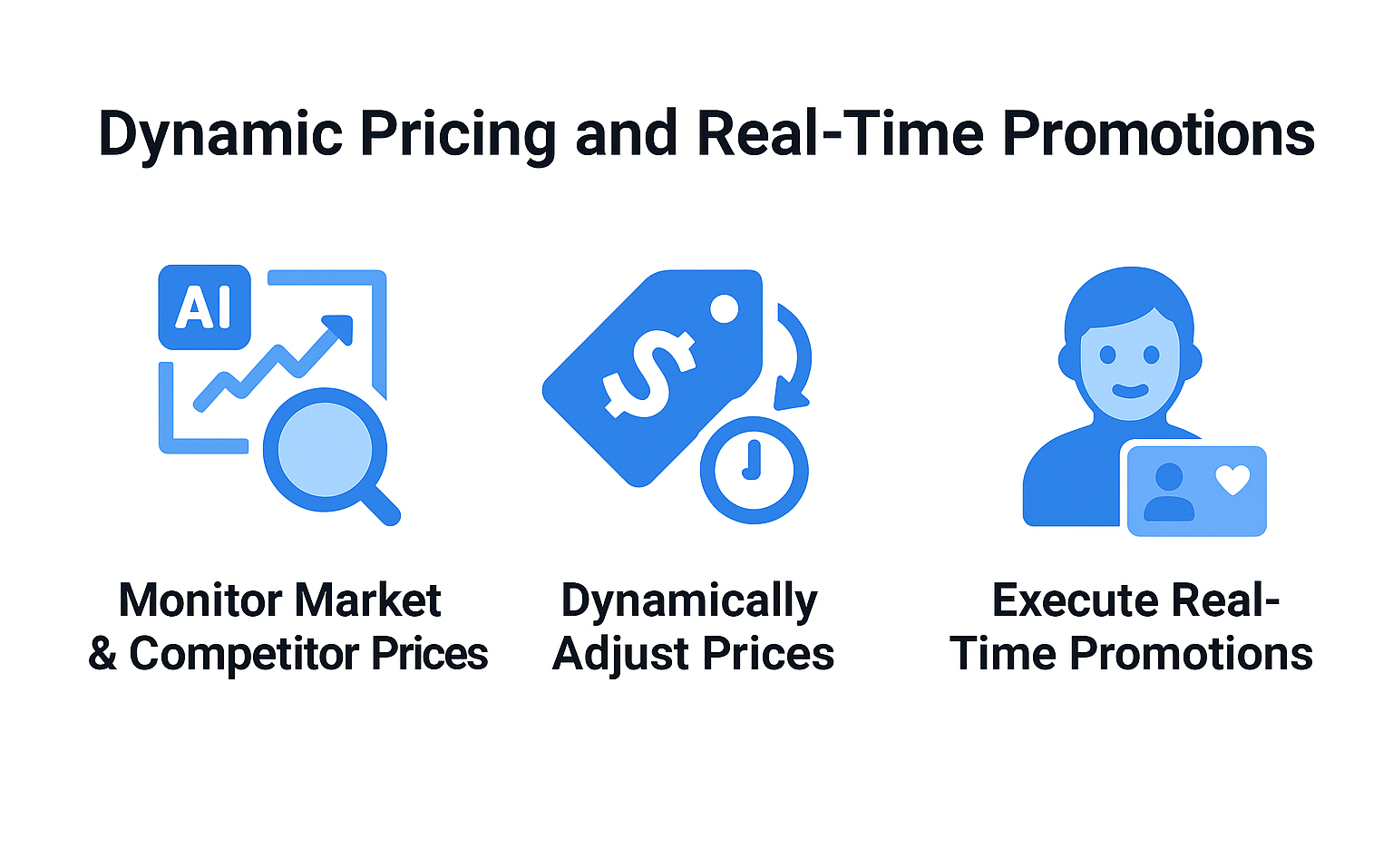 Autonomous promotions go hand-in-hand with this. AI agents can personalize offers to customer segments or loyalty tiers, and even execute just-in-time markdowns to avoid waste. For example, if a batch of sandwiches in a grocery deli is nearing its expiration this evening, an AI agent could instantly apply a 50% off promo for the final two hours of trading to clear stock, all without a manager’s manual approval.
Autonomous promotions go hand-in-hand with this. AI agents can personalize offers to customer segments or loyalty tiers, and even execute just-in-time markdowns to avoid waste. For example, if a batch of sandwiches in a grocery deli is nearing its expiration this evening, an AI agent could instantly apply a 50% off promo for the final two hours of trading to clear stock, all without a manager’s manual approval.
These real-time adjustments drive measurable results. Retailers using agentic dynamic pricing report higher sales and fuller margins by selling more at the optimal price points. Customers also benefit from timely deals and fewer empty shelves. To ensure ethical considerations are upheld, guardrails are set so the AI operates within a clear governance framework, such as no absurd price swings that could alienate shoppers.
When implemented within these rules, the agent’s speed and precision take pricing agility to a new level, far beyond what any team of humans could manage with spreadsheet updates. In essence, dynamic pricing exemplifies agentic AI’s promise. It moves retail from a one-size-fits-all, static approach to a hyper-local, moment-by-moment optimization of revenue and customer value.
Real-World Case Study: AI Agents at Work in Retail
To illustrate how these use cases come together, consider the experience of Walmart, the world’s largest retailer, which has been aggressively deploying AI in its operations. In recent years, Walmart has essentially built an army of digital agents to streamline store and supply chain processes.
The results are eye-opening. For example, Walmart leveraged AI-driven demand forecasting to anticipate store needs with much greater accuracy. A pilot showed that autonomous inventory management could reduce out-of-stock items by up to 30% by predicting demand spikes and triggering replenishment faster than before. Those are real shoppers who now find the products they want, instead of facing empty shelves.
In parallel, Walmart invested in shelf-scanning robotic agents equipped with computer vision that roam aisles to identify issues like missing items or incorrect shelf labels. These autonomous robots alert store staff instantly when they detect a stockout or a pricing error so that it can be fixed in minutes.
This has driven significant improvements in shelf accuracy and ensured promotional pricing is always correctly displayed – a boon for compliance and customer trust. Walmart’s AI agents even extend to pricing strategy. As noted, their systems can dynamically adjust prices in response to competitor moves and local demand, a capability that helped Walmart stay sharp during holiday price wars.
The overarching theme is that Walmart’s early foray into agentic AI has streamlined labor-intensive tasks, boosted in-stock levels, and enhanced the customer experience through more responsive pricing and personalization. And importantly, these autonomous systems operate alongside Walmart’s human associates.
Employees are freed to spend more time assisting customers, while AI handles the number-crunching and routine actions behind the scenes. Walmart’s case underscores a key point. Agentic AI in retail isn’t just a vision; it’s already driving measurable gains in efficiency and sales in the real world.
Last Yard Solutions + Agentic AI: Solving Pain Points Together
While autonomous agents can decide on actions, they still need robust retail systems to execute those actions seamlessly. This is where platforms like Last Yard come in. Last Yard provides a dynamic in-store experience platform with capabilities in digital pricing, signage automation, and compliance management.
By integrating agentic AI with Last Yard, retailers can improve their operations and address longstanding pain points:
Dynamic Pricing on Autopilot
Last Yard’s platform enables centralized, real-time price updates across stores. What once took dozens of staff hours to change paper tags manually now happens with a click. With an AI agent plugged in, that ‘click’ can be triggered by the AI itself based on live data. Imagine an autonomous agent detecting a local competitor’s price drop on a popular item and instantly pushing a price update via Last Yard to match it, all before the next shopper even notices a difference.
The combination of AI decision-making and Last Yard’s rapid execution means retailers can react to market conditions in seconds, not days. This also helps tackle pain points like food waste. The Last Yard platform already supports automatic markdowns (e.g., discounting perishables as they near expiry) to save waste and margin.
An agentic AI could monitor each store’s perishable inventory and dynamically initiate those markdowns at just the right time, maximizing sell-through while minimizing manual oversight. The result? Higher efficiency, less spoilage, and more profitable stores.
Smarter Signage and Content Automation
Last Yard specializes in digital signage and price ticket automation, ensuring information at the shelf is always up-to-date and accurate. This addresses a significant operational pain point, involving labor and errors, specifically, the labor required to update signs and labels.
By integrating agentic AI, retailers can take it a step further. For example, the AI could analyze sales patterns and decide to launch a flash sale on slow-moving stock. Last Yard’s system would then automatically generate new digital shelf labels and promotional signs in the affected stores. No frantic phone calls or emails to stores – the AI agent and Last Yard handle it end-to-end. The AI can also ensure compliance with pricing rules during these changes.
In highly regulated categories such as pharmacy and liquor, Last Yard’s business rules features ensure that promotions meet all legal requirements. The AI agent can operate within these guardrails, executing changes confidently.
This not only saves staff time but also provides retailers with the agility to run truly dynamic in-store campaigns that respond to real-time insights, showcasing their adaptability and responsiveness, while maintaining compliance.
Autonomous Compliance and Audits
Last Yard’s platform provides a single source of truth for pricing and promotional content across the chain, greatly reducing inconsistencies and errors. Integrating an agentic AI with this system means compliance monitoring can be largely hands-off.
The AI agent can continuously compare store data (sales, inventory, and even camera feeds) against the central plan. Suppose it finds a discrepancy, such as a promotion that didn’t go live in a particular store or an item being sold at the wrong price.
In that case, the agent can either auto-correct it by re-sending the correct price to that store’s display or alert the relevant team to intervene. This level of real-time governance also helps avoid costly regulatory fines. It preserves customer trust, especially in industries where accuracy is critical, such as having an incorrect price on a controlled medicine.
As seen with a major supermarket chain in Australia, Last Yard’s centralized approach cuts promotion rollout time by up to 66%. With AI oversight, retailers can ensure those rollouts happen not only fast but also flawlessly, with the agent double-checking that every store is compliant and on-brand.
Ultimately, Last Yard’s robust automation capabilities act as the ‘muscle’ and agentic AI provides the ‘brain’ — together tackling the pain points of slow manual processes, compliance risk, and siloed operations that have long plagued brick-and-mortar retail.
Conclusion: Toward AI-Driven Store Operations
Agentic AI is no longer a buzzword. It’s becoming a pragmatic tool for reinventing retail operations. As early adopters show, autonomous agents can handle routine decisions, reduce inefficiencies, and boost responsiveness, all while freeing human teams to focus on strategy, creativity, and customer relationships. Much like barcode scanners or POS systems once did, AI agents are on track to become standard in modern store environments.
To get there, retailers must invest in integration, real-time data quality, and governance to ensure AI aligns with brand values and customer expectations. The message for retail leaders is clear: those who embrace agentic AI now will gain lasting advantages in efficiency, adaptability, and customer experience, shaping stores that are not just smarter, but better places to shop.

